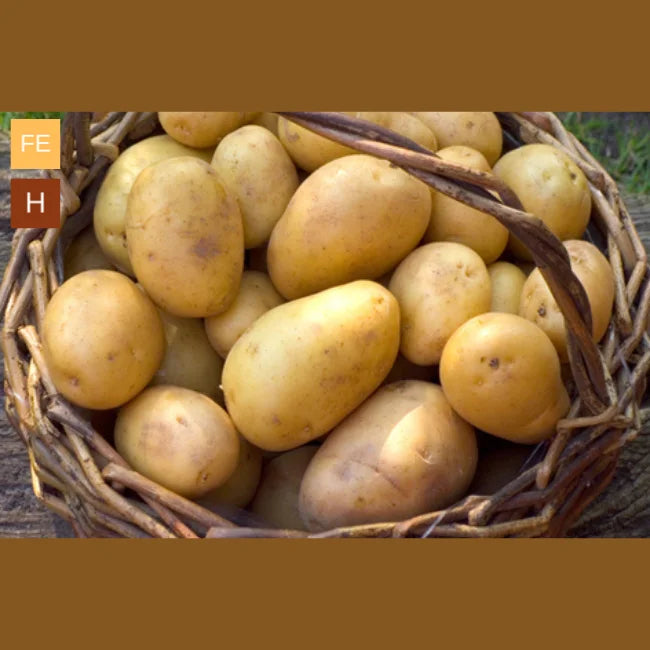Seeds Ireland
Seed Potatoes: Duke Of York (This product & any other product bought along with it will be delivered to you at the start of February 2026)
- Regular price
- €8.95 EUR
- Regular price
-
- Sale price
- €8.95 EUR
- Unit price
- per
Couldn't load pickup availability
Important: This product & any other product bought along with it will be delivered to you at the beginning of February 2026.
If you would like the other items now, please make a separate order.
Name: Seed Potatoes: Duke Of York
Latin Name: Solanum tuberosum
Organic or Conventional: Conventional
Amount: 2kg (Approx 15 to 25 tubers)
Cropping Time: First Early
Seed Potato Size: Minimun size grade of 35mm and a maximum size grade of 60mm
Origin: Ireland/Scotland
Description: A long running heritage variety, highly regarded since its establishment in 1891. Duke of York potatoes have yellow flesh and are oval in shape. Once they are boiled the potatoes are dry and mealy, making them an ideal early to boil straight from your garden. Duke of York has good resistance to dry rot. An all-round option, for any type of culinary endeavour!
Cooking: Use for Baking, Boiling or Salads
When to Plant & Harvest: Early planting in Feb-March for a May harvest.
Plant in April for a June-July harvest.
HOW TO GROW SEED POTATOES
WHERE?
Seed potatoes can grow in almost any soil type, but ideally they prefer to be grown in deep, well-drained, loamy soils that are not too heavy. These can be enriched with plenty of organic materials to help retain water and nutrients for your potatoes to grow big and healthy.
Potatoes don't like the frost, so a south facing site that gets plenty of sun is ideal.
Please note that potatoes are also susceptible to a wide range of pests, including slugs and aphids.
If you are planting potatoes every year, they should be planted in a different position each year. This is known as crop rotation. A minimum of 3-4 years should be left before planting again in the same position. This helps reduce diseases among the crop.
WHEN?
First earlies, second earlies and maincrop – these terms refer simply to how long it takes between planting and harvesting.
Earlies – Plant February to April (when weather turns a little milder), minimum 10 weeks to mature (13-15 weeks for second earlies), harvest around June.
Maincrop - Plant mid to late April, allow approximately 20 weeks to mature, to be harvested August onwards. Maincrop take up the most room in your garden but they are the best varieties to store for eating at a later date.
WHEN YOUR SEED POTATOES ARRIVE
When you receive your seed potatoes you should begin the process of ‘chitting’. This just means encouraging the potato grow a sprout. This is best done in a frost-free sunny area. An easy method is to leave your potatoes in an egg carton, with the blunt end with most eyes facing upwards. The short shoots that appear will help get the potatoes off to a good start when planted. While not essential for maincrop varieties, we strongly recommend chitting for your earlies.
Small green or purple shoots approximately 1 inch long are ideal. Long white shoots are a sign of too much heat and not enough light.
PLANTING
Planting usually starts by making a ‘V’ shaped drill about 5” deep in your soil. Or, if you have limited room and light enough soil you can make a hole to carefully drop your potato into.
Rows should be made 24” apart for Early varieties, and 30” apart for Maincrop.
Seed spacing within the row, Earlies should be placed 12” apart, Maincrop 15”.
After planting out along the drills, carefully cover each potato with a handful of peat or fine soil. Make sure not to snap off the sprouts, they are fragile! The potatoes should have a covering of approx 3” of soil.
Small green or purple shoots approximately 1 inch long are ideal. Long white shoots are a sign of too much heat and not enough light.
EARTHING UP!
As your plants grow, earth or soil needs to be used to cover the potatoes as they begin to show above the surface. This is to prevent the tubers turning green from exposure to light, and therefore inedible.
Earthing up can be done to cover some leaves as well; this will not do your crop any harm. Repeat the process until the ridges become 8 inches high.
FOOD AND WATER
Adding fertiliser can increase yields, but avoid high nitrogen rates as they will delay crop maturity.
Potatoes love moisture, particularly when the tubers begin to form around flowering time. Giving the crop a heavy soaking less often is preferable as this gets down deep through the roots.
Rainfall should be sufficient, especially in Ireland! However, in periods of drought they should be watered.
HARVESTING
When to harvest depends on dates of planting, variety and also weather conditions throughout the season. Generally:
First Earlies – We like to eat when freshly harvested, June-July in small amounts.
Second Earlies – Same as first, small quantities eaten fresh in late June-July.
Maincrop – Lift from September onwards normally. When storing, ensure the tubers are thoroughly dried, and stored in a breathable sack, in a cool, dark dry place.

Share


